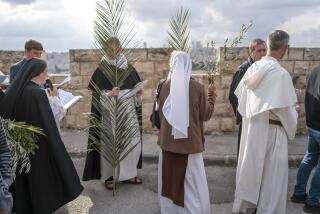An artistic tradition flourishes for Palm Sunday
As a boy growing up in the small town of Tepalcatepec in the Mexican state of Michoacan, Esteban Torres marveled at the intricate palm weavings that artisans and priests distributed each spring.
Now, from a flower shop in a Santa Ana strip mall, Torres preserves the Palm Sunday tradition himself.
Torres, 52, is one of a small number of crafts people who work in the background of Holy Week, weaving palm fronds into elaborate crosses, flowers and geometric shapes that will become tokens of faith in Catholic churches on Palm Sunday.
Every spring, Torres puts in an order for thousands of the fronds, which are harvested from palms in the Yucatan Peninsula. They arrive at the downtown Los Angeles flower market by way of Miami and he transports them, bundle by thick bundle, to his flower shop.
The fronds are long, ribbon-like and flexible; easy to pull apart, thread and fold into spectacular designs. The process takes up to two weeks, and then Torres -- like fellow artisans elsewhere in Southern California Latino communities -- delivers the finished products to a nearby parish.
Torres sells the pieces -- $5 for a flower, $7 for a cross -- but making them is also an act of devotion for him.
“I’m not a perfect Catholic, but this is my way of helping the church,” he said.
Palm Sunday commemorates Jesus’ entrance into Jerusalem, when he rode into the city on a donkey and crowds welcomed him by waving and laying date palm fronds in his path.
For Catholics, the holy day marks the end of the solemn, 40-day season of Lent and the beginning of Holy Week, in which worshipers remember Jesus’ last supper and his crucifixion and culminate the observances by celebrating his resurrection on Easter Sunday.
“Palms were a way of honoring heroes and people of importance, so we are commemorating Jesus’ entrance, which ended up being his death,” said Lesa Truxaw, director of the Office for Worship at the Roman Catholic Diocese of Orange.
Palm art has found an outlet in nearly every culture with a Catholic population. In Vietnam, it is a tradition to weave dragon shapes. In Ireland, Celtic designs are popular. In colder climates where palm fronds are not available, like in Russia, parishes may use olive or willow branches.
In Southern California, church officials say, the most sophisticated palm art is typically found at Latino-dominated parishes.
“It’s a cultural expression of a very traditional Catholic ceremony,” said Ryan Lilyengren, a spokesman for the Diocese of Orange.
When Torres decided to take up palm art 15 years ago, he went door to door in the neighborhood near his shop until he found a few neighbors who knew how to weave palms.
His niece Mireya Torres, 35, soon became the resident expert. When she started weaving nearly a decade ago, it took her an hour to finish a single cross. Now she can make five an hour.
“If I could do it all year, I would,” she says.
But the craft is seasonal. For two weeks every spring, Esteban, Mireya and two employees go into overdrive, churning out 1,500 pieces of palm art.
Yet it requires precision and skill that must be patiently taught and learned.
On Thursday, palm artists Margarita Reyes, 43, and her son George, 20, stood over a small table in the cramped shop, full of Mylar balloons and the aroma of freshly cut flowers. The mood was light and celebratory; Torres cracked jokes as he supervised the handiwork.
Starting with a single bunch of about 25 palm fronds gathered together at the bottom, they take them out of buckets in a walk-in refrigerator, spread them out and begin weaving.
They bend, fold, and braid the pliable fronds, weaving the longest, thickest palms into large crosses made up of patterns that resemble hair braids.
The more slender leaves are formed into rose-like flower blossoms or boxy, pyramid-shaped canastitas -- little baskets.
They use staples to secure the ends and snip off the wayward strands with scissors.
Once they are finished, they place the completed products back into buckets of water, where they soak up water until Palm Sunday when Torres will snip off the soggy bottoms of their stems. The final touch: stapling a prayer card with the Virgin of Guadalupe to the center.
On Sunday, Torres will sell the palms outside Our Lady of the Pillar in Santa Ana before each Mass.
He is also donating several boxes full of single, unwoven palms to the church. The pastor will pass them out. During Mass all the palms will be blessed and sprinkled with holy water, and from the pews, many of the parishioners will try their best to emulate his weavings.
--



